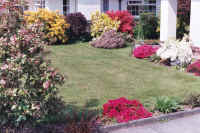|
|
Precautions when transplanting rhododendrons, azaleas, camellias and the like…
Below I have given some extra points to consider when transplanting Rhododendrons, Azaleas, Camellias, Pieris and other Ericaceous shrubs. You can
check the basic method for transplanting shrubs on this link.
Ericaceous plants need special consideration for several reasons.
- They tend to be shallow rooted so don't require a deep hole for planting in. Aim to achieve the same soil level after re-planting.
- Cut out the root ball widely to include the fine feeding roots and make a wide hole for replanting.
- Don't bury the roots deeply under garden soil when re-planting.
- Their roots prefer moist soil. Couple this with a shallow root system and you see the need to keep a careful check on moisture. A dry root zone will kill these shrubs.
- In warm climates transplant rhododendrons in the fall to get the best chance of recovery and re-establishment.
- In cool climates transplanting rhododendrons in spring takes advantage of more active growth for re-establishement.
- Encourage surface feeding roots to spread out by using moisture retentive mulches with plenty of humus.
- These shrubs are averse to limey soils. This is because alkaline conditions cause iron to become insoluble and therefore unavailable for plant uptake and transport. This leads to leaf chlorosis.
- The moist conditions that these shrubs enjoy will naturally lead to acid conditions in an organic soil.
- Incorporate peat substitute and soil conditioners high in humus when planting.
- Never apply lime but aim for a soil ph less than 6.
When transplanting rhododendrons to an alkali soil, perhaps a clay, the plant could grow in an acidic peaty layer overlying the native soil. Make a wide shallow hole for the plant followed by building a ring of peat substitute around and over the roots. Sculpture the soil surface so water drains toward the shrub.

Organic fertilizers to use when transplanting rhododendrons, azalias, camellias ...
Take care with deciduous Azaleas to save as much of the root system as possible. When the root system is small you'll probably need to prune back top-growth to about 6 - 8" from the ground. Avoid siting shrubs like Camellias, Azaleas and Rhododendrons in view of the morning sun if they are likely to flower during periods of frost.
© 2004 - The Organic Gardener.Com.
Enjoy this page? Please pay it forward. Here's how...
Would you prefer to share this page with others by linking to it?
- Click on the HTML link code below.
- Copy and paste it, adding a note of your own, into your blog, a Web page, forums, a blog comment,
your Facebook account, or anywhere that someone would find this page valuable.
|
|


